Spatial Coupling of Population and Economic Densities and the Effect of Topography in Anhui Province, China, at a Grid Scale
Abstract
:1. Introduction
2. Materials and Methods
2.1. Study Area
2.2. Data Sources and Processing
2.3. Research Framework and Methods
2.3.1. Research Framework
2.3.2. Spatial Modeling of Population and Economic Data
2.3.3. Analysis of the Coupling Characteristics of Population and Economy
3. Results
3.1. Division of Population and Economic Characteristics
3.2. Spatialization of Population and Economic Data
3.2.1. Modeling Factor Screening
3.2.2. Spatialized Model Construction
3.2.3. Accuracy Verification
3.3. Spatial Coupling Characteristics of Population and Economy
3.4. Topographic Effect of Population Distribution and Economic Development
3.5. Topographic Effect on the Spatial Coupling Index
4. Discussion
4.1. Comparison of Administrative Units and Grid Units
4.2. Grid-Scale Effects of the Spatialization of Population and Economic Data
5. Conclusions
Author Contributions
Funding
Data Availability Statement
Conflicts of Interest
Appendix A
| Topographic Factor | Level | Population Density/(Persons per km−2) | Economic Density/(10,000 Yuan·km−2) | Size of the Population | Gross Domestic Production (GDP) | ||
|---|---|---|---|---|---|---|---|
| Sum/10,000 Person | Ratio/% | Sum/Billion Yuan | Ratio/% | ||||
| Elevation/(m) | <50 | 645.72 | 3502.65 | 5776.59 | 90.61 | 31,334.69 | 89.11 |
| 50~100 | 300.33 | 2077.93 | 404.81 | 6.35 | 2800.84 | 7.97 | |
| 100~200 | 143.56 | 787.72 | 149.23 | 2.34 | 818.83 | 2.33 | |
| 200~300 | 36.42 | 170.82 | 27.02 | 0.42 | 126.71 | 0.36 | |
| 300~400 | 17.24 | 79.22 | 9.27 | 0.15 | 42.60 | 0.12 | |
| 400~500 | 11.92 | 54.92 | 4.76 | 0.07 | 21.95 | 0.06 | |
| 500~600 | 7.26 | 29.85 | 1.97 | 0.03 | 8.08 | 0.02 | |
| 600~800 | 4.53 | 18.17 | 1.51 | 0.02 | 6.05 | 0.02 | |
| 800~1000 | 2.43 | 11.66 | 0.35 | 0.01 | 1.69 | 0.00 | |
| >1000 | 1.62 | 33.88 | 0.05 | 0.00 | 0.84 | 0.00 | |
| Slope/(°) | <2 | 621.70 | 3414.89 | 4861.98 | 76.29 | 26,705.80 | 75.98 |
| 2~6 | 481.89 | 2682.81 | 1305.45 | 20.48 | 7267.72 | 20.68 | |
| 6~15 | 99.49 | 574.94 | 164.73 | 2.58 | 951.93 | 2.71 | |
| 15~25 | 29.90 | 158.71 | 35.96 | 0.56 | 190.88 | 0.54 | |
| >25 | 11.08 | 70.65 | 5.01 | 0.08 | 31.98 | 0.09 | |
| Topographic Relief/(m) | <30 | 644.86 | 3495.80 | 3367.12 | 52.71 | 18,253.30 | 51.82 |
| 30~70 | 653.29 | 3496.28 | 2199.75 | 34.43 | 11,772.69 | 33.42 | |
| 70~200 | 331.68 | 2101.14 | 695.43 | 10.89 | 4405.46 | 12.51 | |
| 200~500 | 47.86 | 301.47 | 123.39 | 1.93 | 777.32 | 2.21 | |
| >500 | 4.37 | 22.91 | 2.90 | 0.05 | 15.18 | 0.04 | |
References
- Verbavatz, V.; Barthelemy, M. The growth equation of cities. Nature 2020, 7834, 397–401. [Google Scholar] [CrossRef] [PubMed]
- Wiedmann, T.; Allen, C. City footprints and SDGs provide untapped potential for assessing city sustainability. Nat. Commun. 2021, 1, 3758. [Google Scholar] [CrossRef]
- Adam, S. The Wealth of Nations; Random House Inc.: New York, NY, USA, 1994. [Google Scholar]
- Jiang, L.; Deng, X.; Seto, K.C. Multi-level modeling of urban expansion and cultivated land conversion for urban hotspot counties in China. Landsc. Urban Plan. 2012, 41, 131–139. [Google Scholar] [CrossRef]
- Hu, H.Y.; Zhang, S.Y. Essays on China’s Population Distribution; East China Normal University Press: Shanghai, China, 1986. [Google Scholar]
- Zhong, Y.X.; Lu, Y.Q. The coupling relationship between population and economic in Poyang lake ecological economic zone. Econ. Geogr. 2011, 31, 195–200. [Google Scholar]
- Wang, D.H.; Li, X.D. Coordination of population and economic development in the Wujiang river basin of Guizhou province. Sci. Geogr. Sin. 2019, 39, 477–486. [Google Scholar]
- Wu, J.D.; Wang, X.; Wang, C.L.; He, X.; Ye, M.Q. The status and development trend of disaggregation of socio-economic data. J. Geo-Inf. Sci. 2018, 20, 1252–1262. [Google Scholar]
- Bai, Z.Q.; Wang, J.L.; Yang, F. Research progress in spatialization of population data. Prog. Geogr. 2013, 32, 1692–1702. [Google Scholar]
- Roy, D.; Palavalli, B.; Menon, N.; King, R.; Pfeffer, K.; Lees, M.; Sloot, P.M.A. Survey-based socio-economic data from slums in Bangalore, India. Sci. Data 2018, 5, 170200. [Google Scholar] [CrossRef]
- Dong, N.; Yang, X.H.; Cai, H.Y. Research progress and perspective on the spatialization of population data. J. Geo-Inf. Sci. 2016, 18, 1295–1304. [Google Scholar]
- Zhang, J.J.; Zhu, W.B.; Zhu, L.Q.; Cui, Y.P.; He, S.S.; Ren, H. Spatial variation of terrain relief and its impacts on population and economy based on raster data in west Henan mountain area. Acta Geogr. Sin. 2018, 73, 1093–1106. [Google Scholar]
- Lu, X.; Li, J.; Duan, P.; Cheng, F.; Wang, J.L. Spatialization and forecasting of GDP in Yunnan border area based on nighttime light and land use data. Areal Res. Dev. 2020, 39, 36–39. [Google Scholar]
- Igor, K. Geostatistics portal-an integrated system for the dissemination of geo-statistical data. Statistika 2013, 93, 100–108. [Google Scholar]
- Li, F.; Zhang, S.W.; Yang, J.C.; Wang, Q. A review on research about spatialization of socioeconomic data. Geogr. Geo-Inf. Sci. 2014, 30, 102–107. [Google Scholar]
- Yazdian, H.; Salmani, D.N.; Alijanian, M. A spatially promoted SVM model for GRACE downscaling: Using ground and satellite-based datasets. J. Hydrol. 2023, 626, 130214. [Google Scholar] [CrossRef]
- Guo, H.X.; Zhu, W.Q. A review on the spatial disaggregation of socioeconomic statistical data. Acta Geogr. Sin. 2022, 77, 2650–2667. [Google Scholar]
- Velpuri, N.M.; Senay, G.B.; Singh, R.K.; Bohms, S.; Verdin, J.P. A comprehensive evaluation of two MODIS evapotranspiration products over the conterminous United States: Using point and gridded FLUXNET and water balance ET. Remote Sens. Environ. 2013, 139, 35–49. [Google Scholar] [CrossRef]
- Zhang, J.J.; Zhu, W.B.; Zhu, L.Q.; Cui, Y.P.; He, S.S.; Ren, H. Topographical relief characteristics and its impact on population and economy: A case study of the mountainous area in western Henan, China. J. Geogr. Sci. 2019, 29, 598–612. [Google Scholar] [CrossRef]
- Luo, J.; Shi, P.J.; Zhang, X.B. Relationship between topographic factors and population distribution in Lanzhou-Xining urban agglomeration. Econ. Geogr. 2020, 40, 106–115. [Google Scholar]
- Ustaoglu, E.; Williams, B. Institutional settings and effects on agricultural land conversion: A global and spatial analysis of European regions. Land 2022, 12, 47. [Google Scholar] [CrossRef]
- Alahmadi, M.; Mansour, S.; Martin, D.; Atkinson, P.M. An improved index for urban population distribution mapping based on nighttime lights (DMSP-OLS) data: An experiment in Riyadh Province, Saudi Arabia. Remote Sens. 2021, 13, 1171. [Google Scholar] [CrossRef]
- Kumar, P.; Sajjad, H.; Joshi, P.K.; Elvidge, C.D.; Rehman, S.; Chaudhary, B.S.; Tripathy, B.R.; Singh, J.; Pipal, G. Modeling the luminous intensity of Beijing, China using DMSP-OLS night-time lights series data for estimating population density. Phys. Chem. Earth 2019, 109, 26–34. [Google Scholar] [CrossRef]
- Bakillah, M.; Liang, S.; Mobasheri, A.; Arsanjani, J.J.; Zipf, A. Fine-resolution population mapping using OpenStreetMap point-of-interest. Int. J. Geogr. Inf. Sci. 2014, 28, 1940–1963. [Google Scholar] [CrossRef]
- Yeow, L.W.; Low, R.; Tan, Y.X.; Cheah, L. Point-of-Interest (POI) data validation methods: An urban case study. ISPRS Int. J. Geo-Inf. 2021, 10, 735. [Google Scholar] [CrossRef]
- Jonietz, D.; Zipf, A. Defining fitness-for-use for crowdsourced Points of Interest (POI). ISPRS Int. J. Geo-Inf. 2016, 5, 149. [Google Scholar] [CrossRef]
- Deville, P.; Linard, C.; Martin, S.; Gilbert, M.; Stevens, F.R.; Gaughan, A.E.; Blondel, V.D.; Tatem, A.J. Dynamic population mapping using mobile phone data. Proc. Natl. Acad. Sci. USA 2014, 111, 15888–15893. [Google Scholar] [CrossRef] [PubMed]
- Kubícek, P.; Konecny, M.; Stachon, Z.; Shen, J.; Herman, L.; Rezník, T.; Stanek, K.; Stampach, R.; Leitgeb, S. Population distribution modelling at fine spatio-temporal scale based on mobile phone data. Chem. Eng. J. 2019, 12, 1319–1340. [Google Scholar] [CrossRef]
- Wu, Z.Y.; Xu, H.W.; Hu, Z.M. Fine-scale population spatialization based on Tencent location big data: A case study of Moling subdistrict, Jiangning district, Nanjing. Geogr. Geo-Inf. Sci. 2019, 35, 61–65. [Google Scholar]
- Li, H.M.; Luo, D.W.; Dou, S.Q. The estimation of population on multi-spatial scale using Tencent location big data. Bull. Surv. Mapp. 2022, 6, 93–97. [Google Scholar]
- Muhammad, R.; Wanggen, W.; Ofelia, C.; Luc, G. Using location based social media data to observe check in behavior and gender difference: Bringing Weibo data into play. ISPRS Int. J. Geo-Inf. 2018, 7, 196. [Google Scholar]
- Kuang, W.H.; Du, G.M. Analyzing urban population spatial distribution in Beijing proper. J. Geo-Inf. Sci. 2011, 13, 506–512. [Google Scholar] [CrossRef]
- Zhang, C.F.; Qiu, F. A point-based intelligent approach to areal interpolation. Prof. Geogr. 2011, 62, 262–276. [Google Scholar] [CrossRef]
- Weng, C.Y.; Xin, G.X.; Yang, Q.Y. Building of a spatialization model of socioeconomic data in mountainous and hilly regions and its application. J. Southwest Univ. Nat. Sci. Edit. 2018, 40, 96–103. [Google Scholar]
- Yue, T.X.; Wang, Y.A.; Chen, S.P.; Liu, J.Y.; Qiu, D.S.; Deng, X.Z.; Liu, M.L.; Tian, Y.Z. Numerical simulation of population distribution in China. Popul. Environ. 2003, 25, 141–163. [Google Scholar] [CrossRef]
- Cheng, F.L.; Zhao, G.W. Fine-scale simulation of population distribution based on zoning strategy and machine learning. Sci. Surv. Mapp. 2020, 45, 165–173. [Google Scholar]
- Townsend, A.C.; Bruce, D.A. The use of night-time lights satellite imagery as a measure of Australia’s regional electricity consumption and population distribution. Int. J. Remote Sens. 2010, 31, 4459–4480. [Google Scholar] [CrossRef]
- Zheng, H.H.; Gui, Z.P.; Wu, H.Y.; Song, A.H. Developing non-negative spatial autoregressive models for better exploring relation between nighttime light images and land use types. Remote Sens. 2020, 12, 798. [Google Scholar] [CrossRef]
- Morshed, M.M.; Chakraborty, T.; Mazumder, T. Measuring Dhaka’s urban transformation using nighttime light data. J. Geovis. Spat. Anal. 2022, 6, 25–37. [Google Scholar] [CrossRef]
- Chen, Q.; Hou, X.Y.; Wu, L. Comparing of population spatialization models based on land use data and DMSP/OLS data respectively: A case study in the efficient ecological economic zone of the yellow river delta. Hum. Geogr. 2014, 29, 94–100. [Google Scholar]
- Huang, Y.H.; Zhao, C.P.; Song, X.Y.; Chen, J.; Li, Z.H. A semi-parametric geographically weighted (S-GWR) approach for modeling spatial distribution of population. Ecol. Indic. 2018, 85, 1022–1029. [Google Scholar] [CrossRef]
- Fan, J.; Tao, A.J.; Lv, C. The coupling mechanism of the centroids of economic gravity and population gravity and its effect on the regional gap in China. Prog. Geogr. 2010, 29, 87–95. [Google Scholar]
- Gaughan, A.E.; Stevens, F.R.; Linard, C.; Jia, P.; Tatem, A.J. High Resolution population distribution maps for Southeast Asia in 2010 and 2015. PLoS ONE 2013, 8, 55882. [Google Scholar] [CrossRef] [PubMed]
- He, S.S.; Fang, B. Population-economy coupling and its effect on topographic gradients in Anhui province, China based on a grid scale. Tropi. Geogr. 2021, 41, 351–363. [Google Scholar]
- Julian, L.S. Population Growth Economics; Peking University Press: Beijing, China, 1984. [Google Scholar]
- George, H.; Evangelia, P. Demographic changes, labor effort and economic growth: Empirical evidence from Greece. J. Policy Model. 2001, 23, 169–188. [Google Scholar]
- Garza, R.J.; Andrade, V.C.; Martinez, S.K.; Renteria, R.F.; Vallejo, C.P. The Relationship Between Population Growth and Economic Growth in Mexico. Soc. Sci. Electron. Publ. 2016, 36, 97–107. [Google Scholar]
- Zhang, J.W.; Gao, C.; Zhao, J. Research on the changing spatial gravity of China’s population, economy, and industry center: Based on the provincial data from 1978 to 2019. Chin. J. Popul. Sci. 2021, 1, 64–78. [Google Scholar]
- Liang, L.W.; Xian, Y.; Chen, M.X. Evolution trend and influencing factors of regional population and economy gravity center in China since the reform and opening-up. Econ. Geogr. 2022, 42, 93–103. [Google Scholar]
- Xiao, Z.Y.; Guo, G.H. Research on the coordinated evolution of population, economy and environment in the Yangtze River Delta. Environ. Sci. Technol. 2021, 44, 196–205. [Google Scholar]
- Zhao, M.; Di, D.R.; Huang, G.W.; Shi, W.Y. Evolution and coupling between economic and population spatial pattern in Wujiang river basin. Res. Soil Water Conserv. 2022, 29, 298–310. [Google Scholar]
- Lv, D.H.; Zhang, Y.; Liu, Y.Q. Spatial coupling relationship between rural population and economy under the background of rural shrinkage in Songnen plain. Econ. Geogr. 2022, 42, 160–167. [Google Scholar]
- Cai, E.; Zhao, X.; Zhang, S.; Li, L. Spatial agglomeration and coupling coordination of population, economics, and construction land in Chinese prefecture-level cities from 2010 to 2020. Land 2023, 12, 1561. [Google Scholar] [CrossRef]
- Tumwesigye, S.; Vanmaercke, M.; Hemerijckx, L.M.; Opio, J.; Twongyirwe, R.; Van, R.A. Spatial patterns of urbanisation in Sub-Saharan Africa: A case study of Uganda. Dev. S. Afr. 2023, 40, 1–21. [Google Scholar] [CrossRef]
- Alberto, A.R.; Edson, B.C.S. The economic interrelations in Paraná, and new regionalization. Terr. Plural. 2019, 13, 73–92. [Google Scholar]
- Yang, Q.; Wang, Y.D.; Li, L.; Wang, X.Y.; He, L.H. Temporal-spatial coupling analysis between population change trend and socioeconomic development in China from 1952 to 2010. Remote Sens. 2016, 20, 1424–1434. [Google Scholar]
- Wang, Y.; Zou, H.; Duan, X.; Wang, L. Coordinated evolution and influencing factors of population and economy in the Yangtze River economic belt. Int. J. Environ. Res. Public Health 2022, 19, 14395. [Google Scholar] [CrossRef] [PubMed]
- Braum, E.S.; Zanetti, S.S.; Cecílio, R.A.; Pezzopane, J.E.M. Improving maps of daily air temperature considering the effects of topography: Data from Espírito Santo, Brazil (2007–2020). J. S. Am. Earth Sci. 2023, 131, 104627. [Google Scholar] [CrossRef]
- Li, Y.; Yang, X.; Cai, H.; Xiao, L.; Xu, X.; Liu, L. Topographical characteristics of agricultural potential productivity during cropland transformation in China. Sustainability 2014, 7, 96–110. [Google Scholar] [CrossRef]
- Zhou, L.; Xiong, L.Y.; Wang, Y.Q.; Zhou, X.H.; Yang, L. Spatial distribution of poverty-stricken counties in China and their natural topographic characteristics and controlling effects. Econ. Geogr. 2017, 37, 157–166. [Google Scholar]
- Jones, B.; O’Neill, B.C. Spatially explicit global population scenarios consistent with the shared socioeconomic pathways. Environ. Res. Lett. 2016, 11, 084003. [Google Scholar] [CrossRef]
- Yang, Z.; Hong, Y.; Guo, Q.B.; Yu, X.X.; Zhao, M.S. The impact of topographic relief on population and economy in the southern Anhui mountainous area, China. Sustainability 2022, 14, 14332. [Google Scholar] [CrossRef]
- Zhang, M.M.; Zhang, L.J.; Qin, Y.C.; Yang, X.W.; Tian, M.N.; Liu, X.F. Spatial pattern and influencing factors of small town population and economic growth and contraction in the Yellow River Basin. Prog. Geogr. 2022, 41, 999–1011. [Google Scholar] [CrossRef]
- Janina, K.; Justice, N.I.; Michael, T.; Sangeetha, S.; Sven, L.; Christine, F. Peri-urban land use pattern and its relation to land use planning in Ghana, West Africa. Landsc. Urban Plan. 2017, 165, 280–294. [Google Scholar]
- Guo, L.B.; Zhao, D.; Chen, G.L.; Yan, L.J.; Feng, P.Y.; Wang, Y. Spatio-temporal characteristics of land use in Zhengzhou city from 2000 to 2020. Areal Res. Dev. 2023, 42, 149–154. [Google Scholar]
- Zhao, M.L.; Li, T.S.; Li, J.L. Study on the consistency and influencing factors of population and economic spatial distribution in the Weihe river basin. Res. Soil Water. Conserv. 2023, 30, 325–334. [Google Scholar]
- Wei, F.; Jiang, Y.H. The spatial distribution of population and regional economic development of Anhui province. Northwest. Popul. 2013, 34, 79–84. [Google Scholar]
- Wen, R.X.; Zhao, C.Y.; Sun, Y.J.; Zheng, Y.R. Spatial coupling distribution of regional population and economic development–take Anhui province as an example. Sci. Technol. Ind. 2019, 19, 1–11. [Google Scholar]
- Wang, S.P.; Fang, Y.L. Research on spatio-temporal coupling characteristics of population-economy in counties of Anhui province from 1998 to 2015. Resour. Dev. Mark. 2017, 33, 1364–1370. [Google Scholar]
- Dai, W.L.; Zhang, S.J.; Li, T.Q. The coupling analysis of population and economy in Anhui province. J. Hebei Agric. Univ. Soc. Sci. 2020, 22, 28–35. [Google Scholar]
- Li, S.C.; Cai, Y.L. Some scaling issues of geography. Geogr. Res. 2005, 24, 11–18. [Google Scholar]
- Atkinson, P.; Curran, P. Choosing an appropriate spatial resolution for remote sensing investigations. Photogramm. Eng. Remote Sens. 1997, 63, 1345–1351. [Google Scholar]
- Ye, J.; Yang, X.H.; Jiang, D. The grid scale effect analysis on town leveled population statistical data spatialization. J. Geo-Inf. Sci. 2010, 12, 40–47. [Google Scholar] [CrossRef]
- Hanberry, B.B. Imposing consistent global definitions of urban populations with gridded population density models: Irreconcilable differences at the national scale. Landsc. Urban Plan. 2022, 226, 104493. [Google Scholar] [CrossRef]
- Mc Shane, C.; Uhl, J.H.; Leyk, S. Gridded land use data for the conterminous United States 1940–2015. Sci. Data 2022, 9, 493. [Google Scholar] [CrossRef]
- Luo, Y.Z.; Dong, C.; Zhang, Y. Study on the method of evaluating the suitable grid for population spatialization. J. Geo-Inf. Sci. 2023, 25, 896–908. [Google Scholar]
- Shoman, W.; Alganci, U.; Demirel, H. A comparative analysis of gridding systems for point-based land cover/use analysis. Geocarto Int. 2019, 34, 867–886. [Google Scholar] [CrossRef]

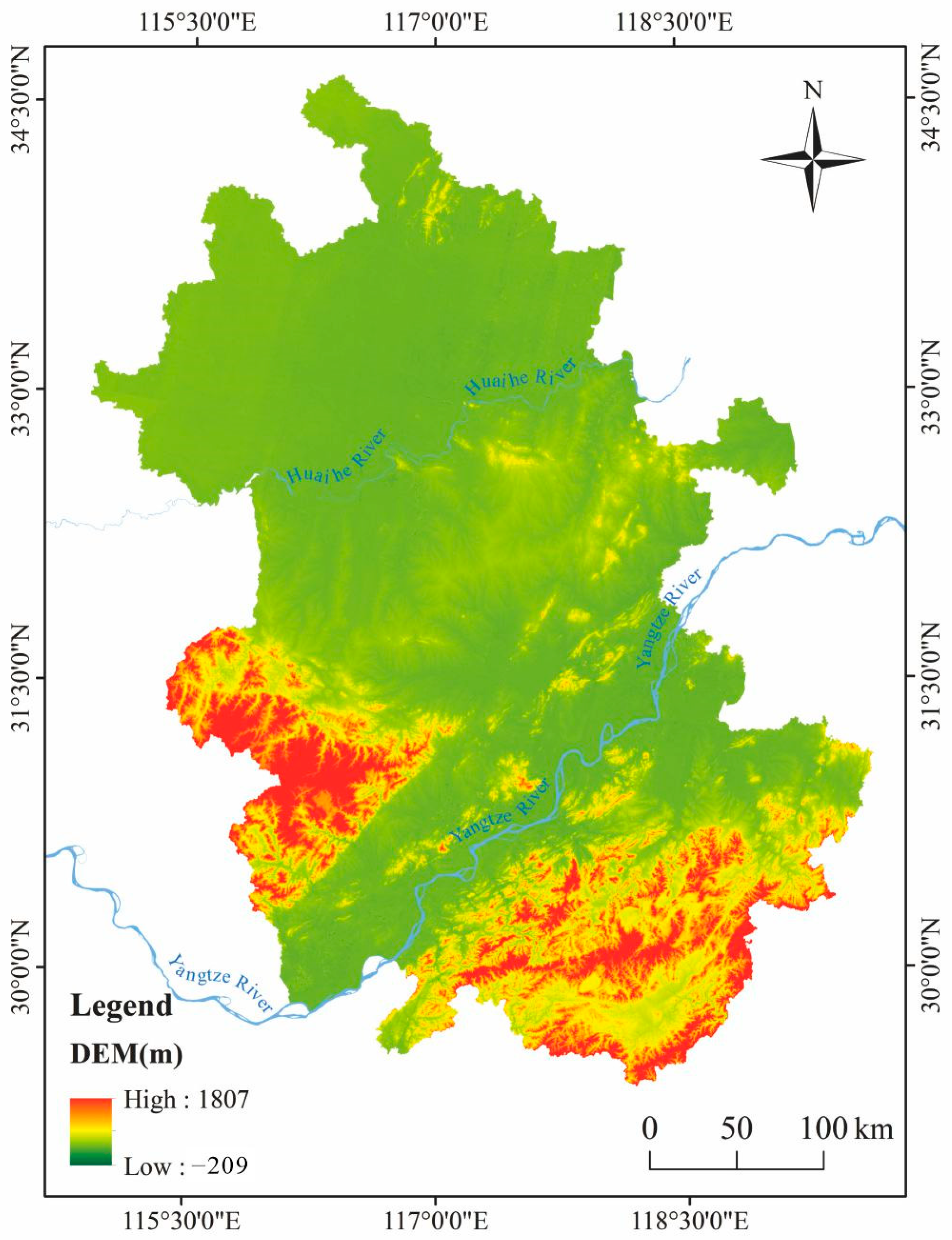

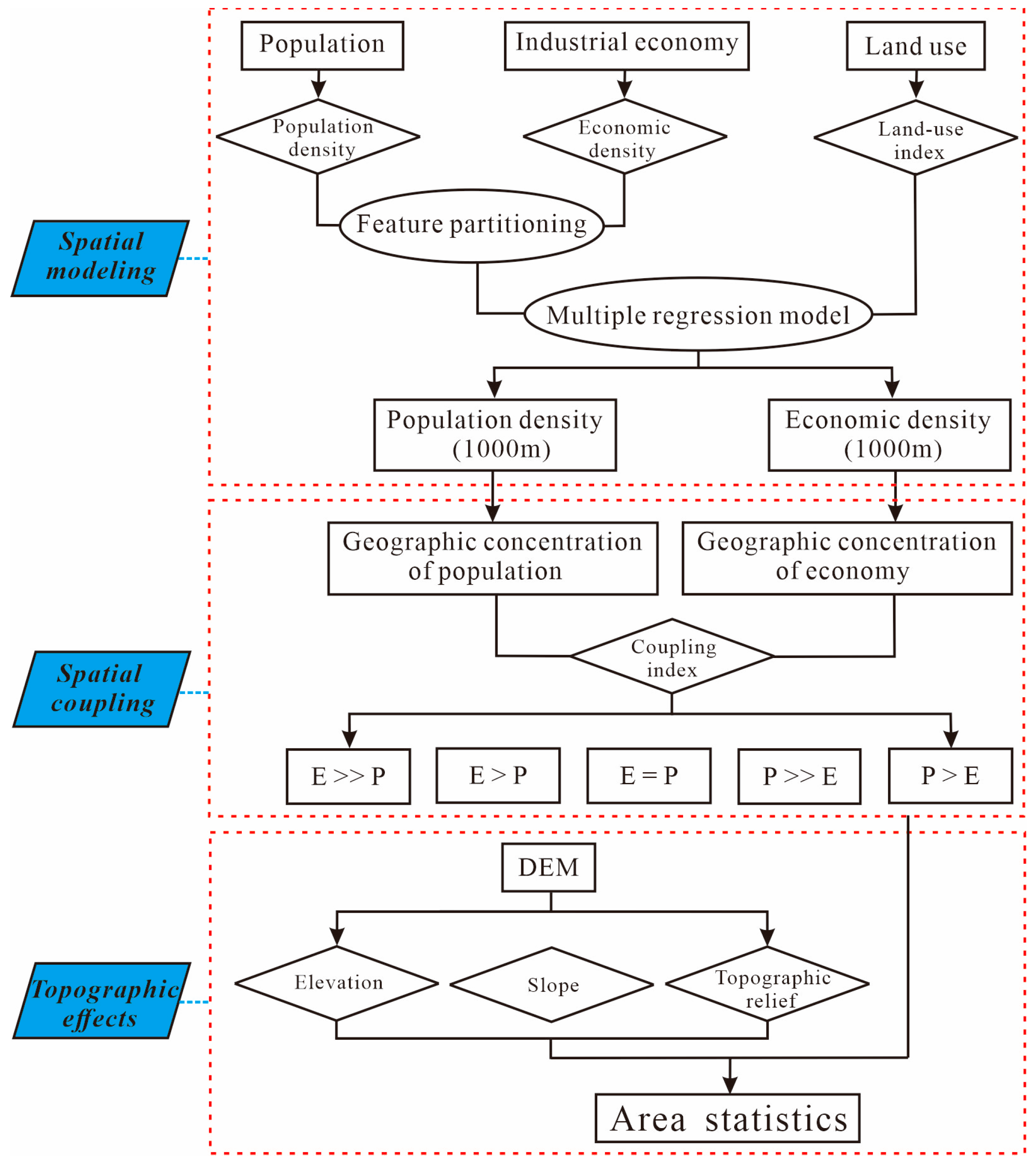
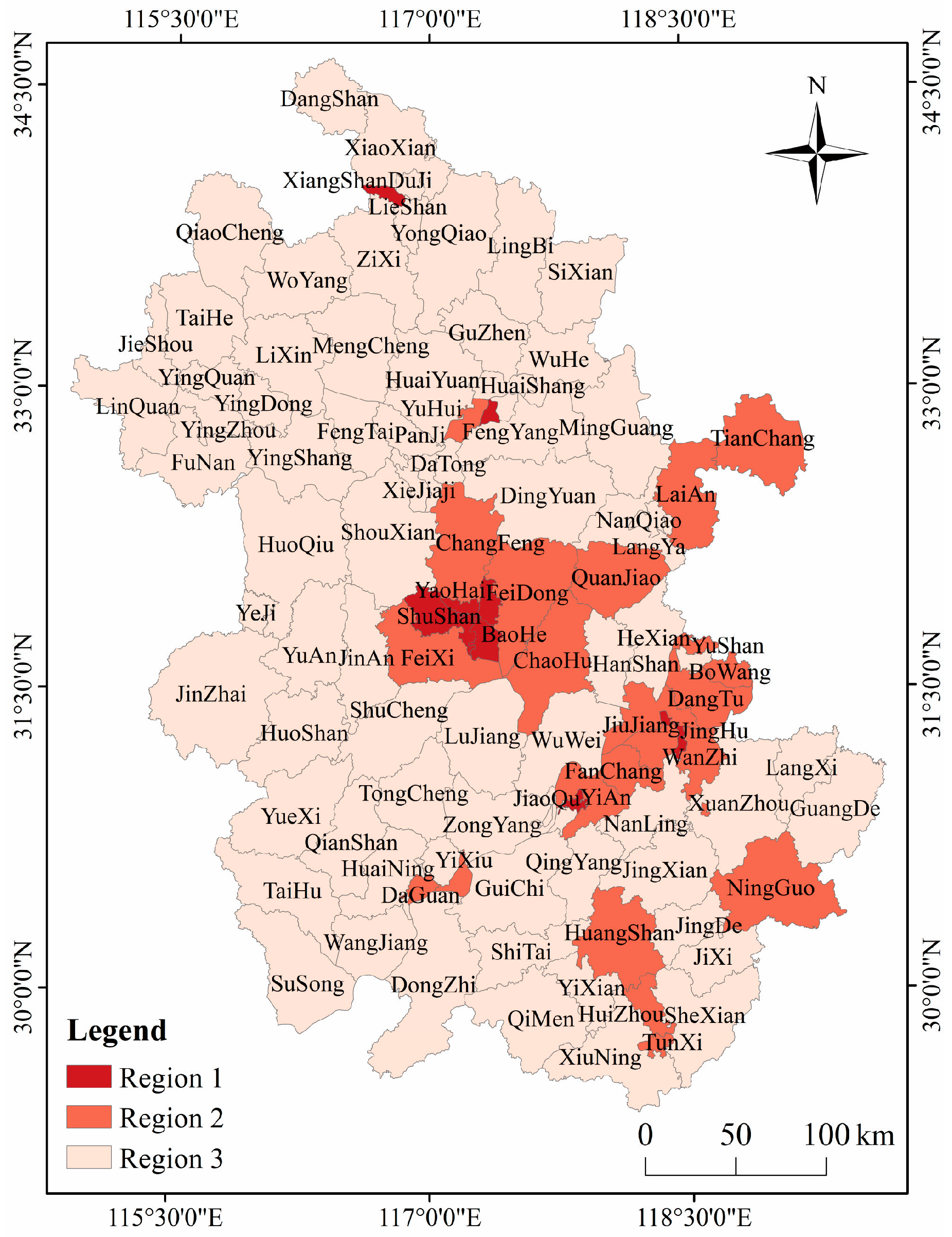
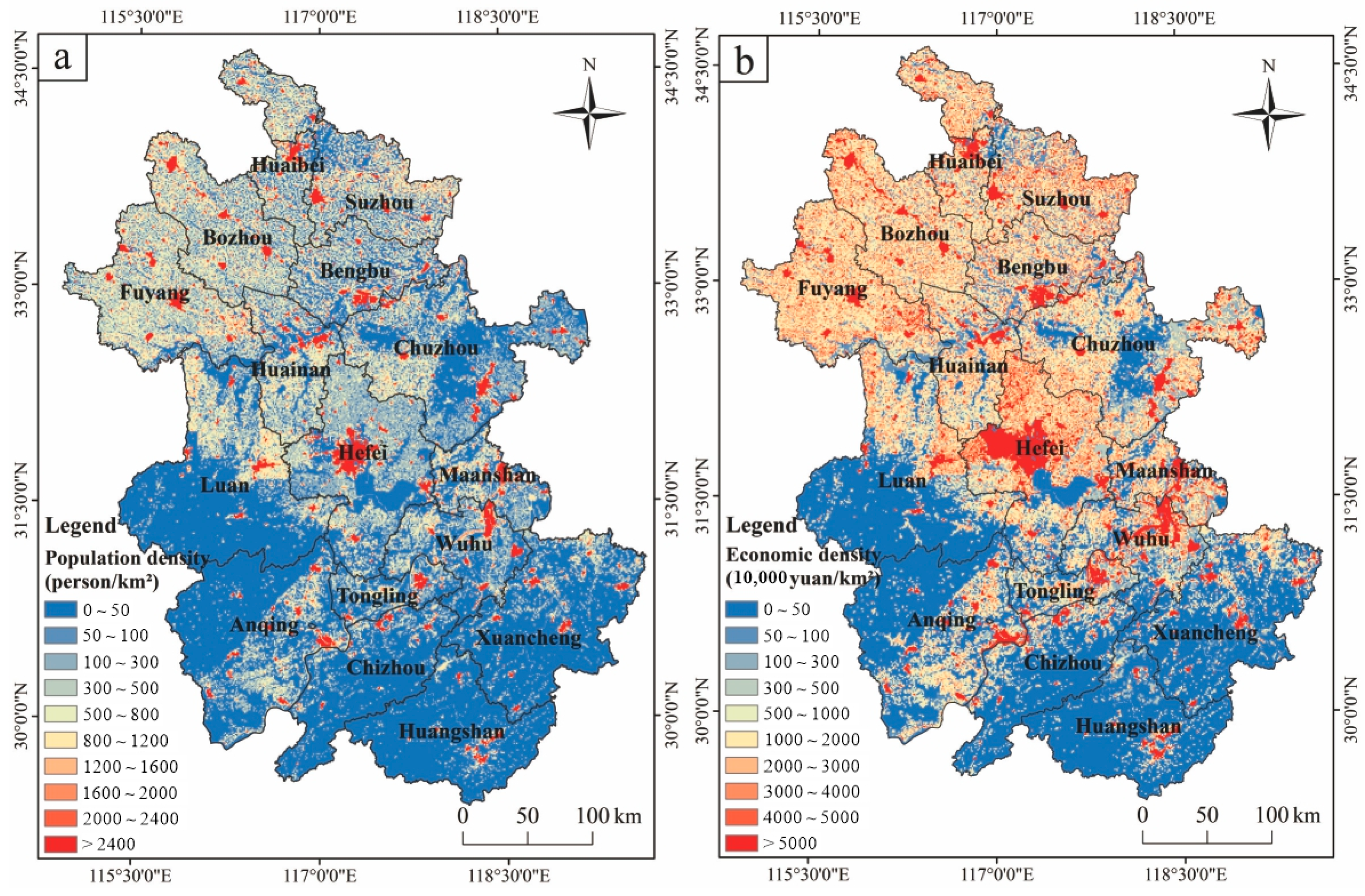


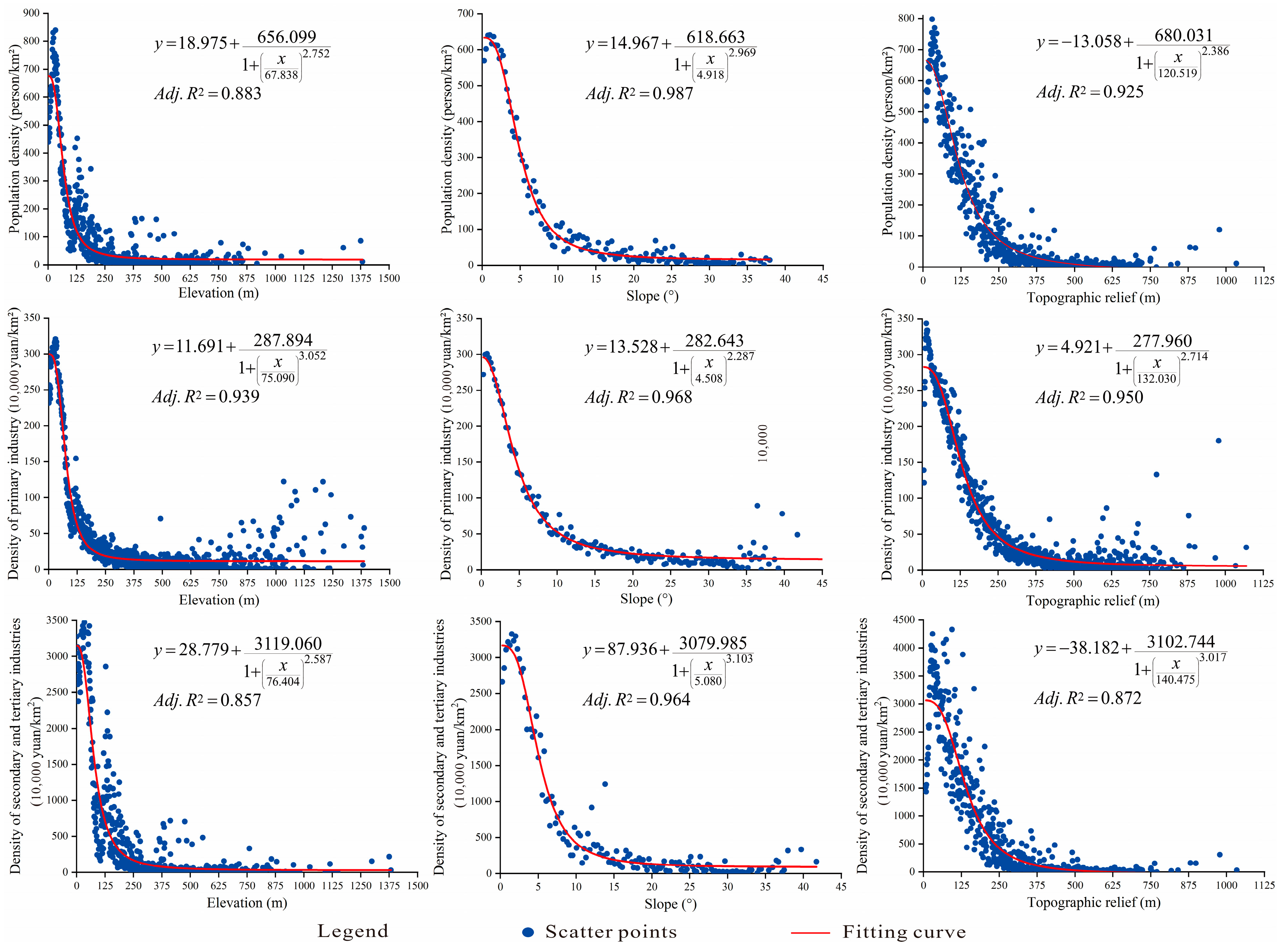
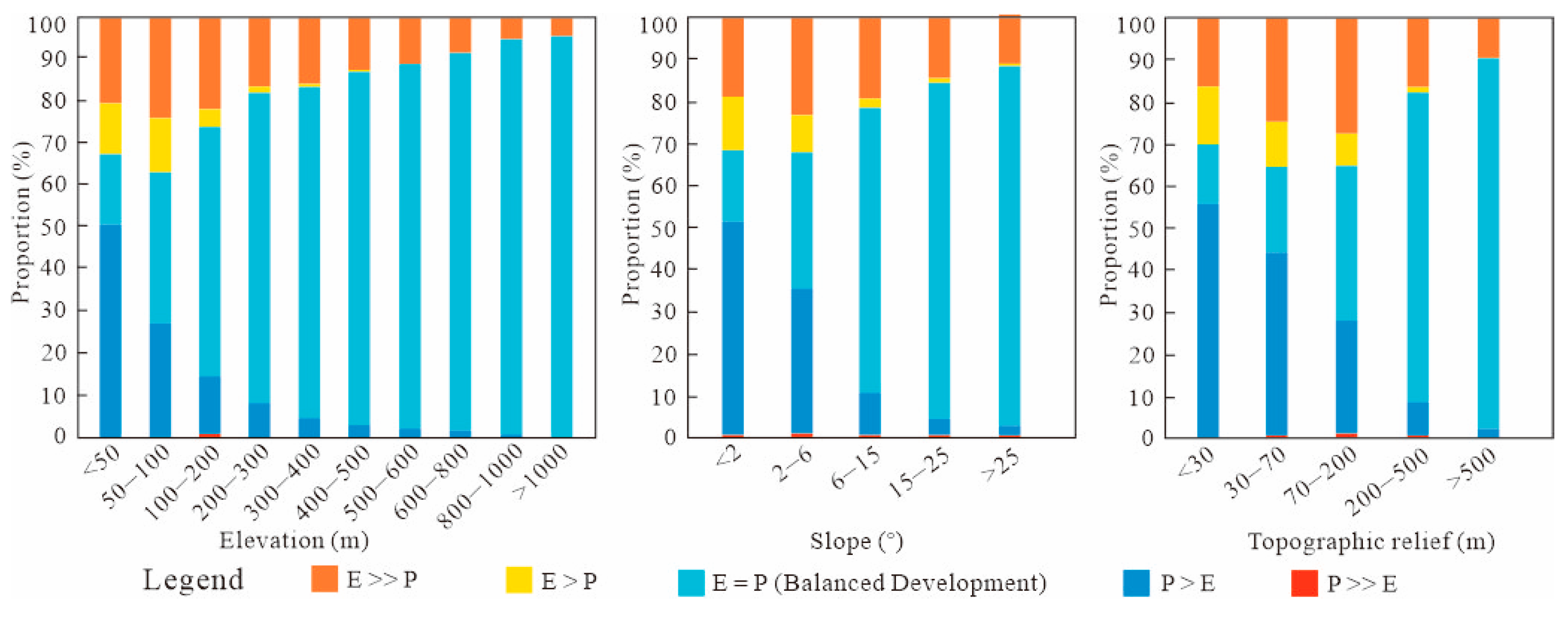
| Level | Land Use Type | |||||
|---|---|---|---|---|---|---|
| Category I | Farmland X1 | Woodland X2 | Grassland X3 | Water X4 | Building land X5 | Unutilized land X6 |
| Category II | Paddy field X11 | Woodland X21 | High-coverage grassland X31 | River and canals X41 | Urban land X51 | Bare land X65 |
| Dry land X12 | Shrubland X22 | Medium-coverage grassland X32 | Lake X42 | Rural residential land X52 | Bare rock X66 | |
| Open woodland X23 | Low-coverage grassland X33 | Reservoir pit X43 | Other construction land X53 | |||
| Other woodland X24 | Shoal X44 | |||||
| Type | Content | Range |
|---|---|---|
| E >> P, Economic polarization | The economic density is much higher than the population density | I > 2.0 |
| E > P, Economic advance | The economic density is slightly higher than the population density | 1.2 < I ≤ 2.0 |
| E = P, Balanced development | The population and economic densities are the same | 0.8 < I ≤ 1.2 |
| P > E, Population advance | The population density is slightly higher than the economic density | 0.5 < I ≤ 0.8 |
| P >> E, Population polarization | The population density is much higher than the economic density | I ≤ 0.5 |
| X11 | X12 | X21 | X22 | X23 | X24 | X31 | X32 | X33 | ||
|---|---|---|---|---|---|---|---|---|---|---|
| Whole Region | Y1 | 0.502 | 0.337 | 0.141 | 0.160 | 0.051 | 0.163 | 0.235 | 0.203 | 0.071 |
| Y21 | 0.663 | 0.795 | 0.302 | 0.304 | 0.140 | 0.333 | 0.423 | 0.085 | 0.268 | |
| Y22 | 0.436 | 0.152 | 0.091 | 0.097 | 0.037 | 0.091 | 0.153 | 0.181 | 0.053 | |
| Region 1 | Y1 | 0.909 | 0.441 | 0.704 | 0.414 | 0.000 | 0.321 | 0.568 | 0.000 | 0.000 |
| Y21 | 0.687 | 0.795 | 0.549 | 0.120 | 0.000 | 0.684 | 0.541 | 0.000 | 0.000 | |
| Y22 | 0.931 | 0.241 | 0.506 | 0.274 | 0.000 | 0.235 | 0.438 | 0.000 | 0.000 | |
| Region 2 | Y1 | 0.550 | 0.648 | 0.334 | 0.461 | 0.104 | 0.361 | 0.493 | 0.572 | 0.195 |
| Y21 | 0.893 | 0.585 | 0.346 | 0.443 | 0.167 | 0.398 | 0.612 | 0.095 | 0.446 | |
| Y22 | 0.545 | 0.578 | 0.333 | 0.465 | 0.115 | 0.368 | 0.491 | 0.657 | 0.207 | |
| Region 3 | Y1 | 0.529 | 0.637 | 0.213 | 0.240 | 0.111 | 0.259 | 0.320 | 0.296 | 0.107 |
| Y21 | 0.595 | 0.854 | 0.294 | 0.288 | 0.159 | 0.350 | 0.388 | 0.119 | 0.209 | |
| Y22 | 0.549 | 0.520 | 0.224 | 0.234 | 0.121 | 0.229 | 0.323 | 0.406 | 0.124 | |
| X41 | X42 | X43 | X44 | X51 | X52 | X53 | X65 | X66 | ||
| Whole Region | Y1 | 0.336 | 0.257 | 0.588 | 0.261 | 0.962 | 0.636 | 0.629 | 0.068 | 0.347 |
| Y21 | 0.417 | 0.378 | 0.591 | 0.505 | 0.406 | 0.906 | 0.444 | 0.199 | 0.157 | |
| Y22 | 0.286 | 0.238 | 0.529 | 0.194 | 0.855 | 0.612 | 0.608 | 0.040 | 0.257 | |
| Region 1 | Y1 | 0.336 | 0.327 | 0.765 | 0.342 | 0.995 | 0.919 | 0.805 | 0.000 | 0.107 |
| Y21 | 0.461 | 0.310 | 0.514 | 0.323 | 0.792 | 0.737 | 0.571 | 0.000 | 0.000 | |
| Y22 | 0.441 | 0.373 | 0.831 | 0.376 | 0.904 | 0.900 | 0.632 | 0.000 | 0.270 | |
| Region 2 | Y1 | 0.724 | 0.401 | 0.628 | 0.670 | 0.951 | 0.790 | 0.640 | 0.000 | 0.237 |
| Y21 | 0.427 | 0.548 | 0.696 | 0.695 | 0.579 | 0.906 | 0.668 | 0.000 | 0.218 | |
| Y22 | 0.737 | 0.396 | 0.586 | 0.653 | 0.957 | 0.767 | 0.613 | 0.000 | 0.276 | |
| Region 3 | Y1 | 0.514 | 0.243 | 0.665 | 0.317 | 0.888 | 0.757 | 0.687 | 0.163 | 0.193 |
| Y21 | 0.582 | 0.349 | 0.622 | 0.453 | 0.449 | 0.937 | 0.395 | 0.228 | 0.284 | |
| Y22 | 0.522 | 0.220 | 0.681 | 0.309 | 0.915 | 0.667 | 0.772 | 0.201 | 0.235 |
| Region | OLS—Regression Equation | Adj. R2 |
|---|---|---|
| Whole Region | Y1 = 142.353X51 + 24.820X52 − 45.568X53 | 0.942 |
| Y21 = 3.690X11 + 4.672X12 − 0.091X52 | 0.901 | |
| Y22 = 1404.457X51 + 86.302X52 − 1835.83X53 | 0.742 | |
| Region 1 | Y1 = −17.04X11 + 254.189X21 + 57.021X43 + 174.190X51 + 62.805X52 − 418.063X53 | 0.973 |
| Y21 = 4.523X11 + 6.542X12 + 117.198X24 + 1.785X51 − 12.055X52 | 0.909 | |
| Y22 = 441.003X11 + 3895.294X43 + 664.685X51 + 358.193X52 − 4616.929X53 | 0.872 | |
| Region 2 | Y1 = −2.013X12 + 16.323X41 + 9.048X43 − 2.992X44 + 98.252X51 + 19.007X52 + 80.818X53 | 0.943 |
| Y21 = 1.826X11 + 4.896X31 + 8.383X43 + 8.738X44 + 13.803X52 − 16.902X53 | 0.832 | |
| Y22 = 7069.648X32 + 170.722X41 + 130.43X44 + 690.009X51 + 140.731X52 + 535.243X53 | 0.951 | |
| Region 3 | Y1 = −1.100X12 − 7.518X43 + 84.674X51 + 36.419X52 + 40.704X53 | 0.933 |
| Y21 = 0.747X12 + 21.616X43 + 19.449X52 | 0.893 | |
| Y22 = 7.036X43 + 368.929X51 + 92.168X52 + 559.982X53 | 0.928 |
Disclaimer/Publisher’s Note: The statements, opinions and data contained in all publications are solely those of the individual author(s) and contributor(s) and not of MDPI and/or the editor(s). MDPI and/or the editor(s) disclaim responsibility for any injury to people or property resulting from any ideas, methods, instructions or products referred to in the content. |
© 2023 by the authors. Licensee MDPI, Basel, Switzerland. This article is an open access article distributed under the terms and conditions of the Creative Commons Attribution (CC BY) license (https://creativecommons.org/licenses/by/4.0/).
Share and Cite
Yang, Z.; Hong, Y.; Zhai, G.; Wang, S.; Zhao, M.; Liu, C.; Yu, X. Spatial Coupling of Population and Economic Densities and the Effect of Topography in Anhui Province, China, at a Grid Scale. Land 2023, 12, 2128. https://doi.org/10.3390/land12122128
Yang Z, Hong Y, Zhai G, Wang S, Zhao M, Liu C, Yu X. Spatial Coupling of Population and Economic Densities and the Effect of Topography in Anhui Province, China, at a Grid Scale. Land. 2023; 12(12):2128. https://doi.org/10.3390/land12122128
Chicago/Turabian StyleYang, Zhen, Yang Hong, Guofang Zhai, Shihang Wang, Mingsong Zhao, Chao Liu, and Xuexiang Yu. 2023. "Spatial Coupling of Population and Economic Densities and the Effect of Topography in Anhui Province, China, at a Grid Scale" Land 12, no. 12: 2128. https://doi.org/10.3390/land12122128
APA StyleYang, Z., Hong, Y., Zhai, G., Wang, S., Zhao, M., Liu, C., & Yu, X. (2023). Spatial Coupling of Population and Economic Densities and the Effect of Topography in Anhui Province, China, at a Grid Scale. Land, 12(12), 2128. https://doi.org/10.3390/land12122128





